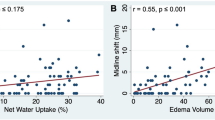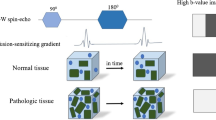Abstract
Purpose
Pathogenesis of peritumoral brain edema (PTBE) in meningiomas remains unclear. Associations between PTBE volume and diffusion or perfusion properties of meningioma have not been studied. We aimed to investigate if diffusion and perfusion properties of meningioma correlate with its PTBE volume.
Methods
Seventy consecutive patients (mean age, 58.9 ± 13.7 years; 37 women) with meningiomas who had preoperative DTI and DSC-PWI were retrospectively analyzed. PTBE volume, tumor volume, and mean T2 signal, ADC, FA, and CBV of the tumor were measured. Between meningiomas with and without PTBE, patient age and sex, as well as T2 signal intensity, volume, ADC, FA, and CBV of tumors, were compared. In meningiomas with PTBE, correlations of PTBE volume with patient age and sex, as well as T2 signal intensity, volume, ADC, FA, and CBV of tumors, were analyzed. Multivariable linear regression analysis was performed to identify factors associated with PTBE volume.
Results
On univariable analysis, meningiomas without PTBE were more frequently found in women (P = 0.033) and demonstrated lower ADC (P = 0.020), higher FA (P < 0.001), and lower CBV (P < 0.001). PTBE volume of meningiomas correlated with tumor ADC (r = 0.444; P = 0.001), tumor FA (r = − 0.655; P < 0.001), and tumor CBV (r = 0.402; P = 0.003). On multivariable analysis, tumor FA was the only factor associated with PTBE volume (P < 0.001).
Conclusion
PTBE volume in meningioma correlates with tumor FA. DTI may help to understand the mechanism of PTBE in meningiomas.




Similar content being viewed by others
References
Ostrom QT, Cioffi G, Gittleman H, Patil N, Waite K, Kruchko C, Barnholtz-Sloan JS (2019) CBTRUS statistical report: primary brain and other central nervous system tumors diagnosed in the United States in 2012-2016. Neuro-Oncology 21:v1–v100
Hou J, Kshettry VR, Selman WR, Bambakidis NC (2013) Peritumoral brain edema in intracranial meningiomas: the emergence of vascular endothelial growth factor-directed therapy. Neurosurg Focus 35:E2
Simis A, Pires de Aguiar PH, Leite CC, Santana PA Jr, Rosemberg S, Teixeira MJ (2008) Peritumoral brain edema in benign meningiomas: correlation with clinical, radiologic, and surgical factors and possible role on recurrence. Surg Neurol 70:471–477
Sindou MP, Alaywan M (1998) Most intracranial meningiomas are not cleavable tumors: anatomic-surgical evidence and angiographic predictibility. Neurosurgery 42:476–480
Mantle RE, Lach B, Delgado MR, Baeesa S, Belanger G (1999) Predicting the probability of meningioma recurrence based on the quantity of peritumoral brain edema on computerized tomography scanning. J Neurosurg 91:375–383
Bitzer M, Wockel L, Morgalla M, Keller C, Friese S, Heiss E, Meyermann R, Grote E, Voigt K (1997) Peritumoural brain oedema in intracranial meningiomas: influence of tumour size, location and histology. Acta Neurochir 139:1136–1142
Lee KJ, Joo WI, Rha HK, Park HK, Chough JK, Hong YK, Park CK (2008) Peritumoral brain edema in meningiomas: correlations between magnetic resonance imaging, angiography, and pathology. Surg Neurol 69:350–355
Paek SH, Kim CY, Kim YY, Park IA, Kim MS, Kim DG, Jung HW (2002) Correlation of clinical and biological parameters with peritumoral edema in meningioma. J Neuro-Oncol 60:235–245
Tamiya T, Ono Y, Matsumoto K, Ohmoto T (2001) Peritumoral brain edema in intracranial meningiomas: effects of radiological and histological factors. Neurosurgery 49:1046–1051
Kim BW, Kim MS, Kim SW, Chang CH, Kim OL (2011) Peritumoral brain edema in meningiomas : correlation of radiologic and pathologic features. J Korean Neurosurg Soc 49:26–30
Nakano T, Asano K, Miura H, Itoh S, Suzuki S (2002) Meningiomas with brain edema: radiological characteristics on MRI and review of the literature. Clin Imaging 26:243–249
Sapkota MR, Yang Z, Zhu D, Zhang Y, Yuan T, Gao J, Si T, Wang J (2020) Evaluation of epidemiologic factors, radiographic features, and pathologic findings for predicting peritumoral brain edema in meningiomas. J Magn Reson Imaging 52:174–182
Osawa T, Tosaka M, Nagaishi M, Yoshimoto Y (2013) Factors affecting peritumoral brain edema in meningioma: special histological subtypes with prominently extensive edema. J Neuro-Oncol 111:49–57
Kim JH, Moon KS, Jung JH, Jang WY, Jung TY, Kim IY, Lee KH, Jung S (2019) Importance of collateral venous circulation on indocyanine green videoangiography in intracranial meningioma resection: direct evidence for venous compression theory in peritumoral edema formation. J Neurosurg:1–9
Zaharchuk G (2007) Theoretical basis of hemodynamic MR imaging techniques to measure cerebral blood volume, cerebral blood flow, and permeability. AJNR Am J Neuroradiol 28:1850–1858
Le Bihan D (2013) Apparent diffusion coefficient and beyond: what diffusion MR imaging can tell us about tissue structure. Radiology 268:318–322
Azizyan A, Eboli P, Drazin D, Mirocha J, Maya MM, Bannykh S (2014) Differentiation of benign angiomatous and microcystic meningiomas with extensive peritumoral edema from high grade meningiomas with aid of diffusion weighted MRI. Biomed Res Int 2014:650939
Toh CH, Castillo M, Wong AM, Wei KC, Wong HF, Ng SH, Wan YL (2008) Differentiation between classic and atypical meningiomas with use of diffusion tensor imaging. AJNR Am J Neuroradiol 29:1630–1635
Toh CH, Wei KC, Chang CN, Peng YW, Ng SH, Wong HF, Lin CP (2014) Assessment of angiographic vascularity of meningiomas with dynamic susceptibility contrast-enhanced perfusion-weighted imaging and diffusion tensor imaging. AJNR Am J Neuroradiol 35:263–269
Kang Y, Wei KC, Toh CH (2019) Can we predict intraoperative blood loss in meningioma patients? Application of dynamic susceptibility contrast-enhanced magnetic resonance imaging. J Neuroradiol doi: https://doi.org/10.1016/j.neurad.2019.10.003
Toh CH, Wong AM, Wei KC, Ng SH, Wong HF, Wan YL (2007) Peritumoral edema of meningiomas and metastatic brain tumors: differences in diffusion characteristics evaluated with diffusion-tensor MR imaging. Neuroradiology 49:489–494
Server A, Kulle B, Maehlen J, Josefsen R, Schellhorn T, Kumar T, Langberg CW, Nakstad PH (2009) Quantitative apparent diffusion coefficients in the characterization of brain tumors and associated peritumoral edema. Acta Radiol 50:682–689
Kinoshita M, Goto T, Okita Y, Kagawa N, Kishima H, Hashimoto N, Yoshimine T (2010) Diffusion tensor-based tumor infiltration index cannot discriminate vasogenic edema from tumor-infiltrated edema. J Neuro-Oncol 96:409–415
Bitzer M, Klose U, Geist-Barth B, Nägele T, Schick F, Morgalla M, Claussen CD, Voigt K (2002) Alterations in diffusion and perfusion in the pathogenesis of peritumoral brain edema in meningiomas. Eur Radiol 12:2062–2076
Mukherjee P, Berman JI, Chung SW, Hess CP, Henry RG (2008) Diffusion tensor MR imaging and fiber tractography: theoretic underpinnings. AJNR Am J Neuroradiol 29:632–641
Boxerman JL, Schmainda KM, Weisskoff RM (2006) Relative cerebral blood volume maps corrected for contrast agent extravasation significantly correlate with glioma tumor grade, whereas uncorrected maps do not. AJNR Am J Neuroradiol 27:859–867
Toh CH, Wei KC, Chang CN, Ng SH, Wong HF (2013) Differentiation of primary central nervous system lymphomas and glioblastomas: comparisons of diagnostic performance of dynamic susceptibility contrast-enhanced perfusion MR imaging without and with contrast-leakage correction. AJNR Am J Neuroradiol 34:1145–1149
Sundar H, Shen D, Biros G, Xu C, Davatzikos C (2007) Robust computation of mutual information using spatially adaptive meshes. Med Image Comput Comput Assist Interv 10:950–958
Lobato RD, Alday R, Gomez PA, Rivas JJ, Dominguez J, Cabrera A, Madero S, Ayerbe J (1996) Brain oedema in patients with intracranial meningioma. Correlation between clinical, radiological, and histological factors and the presence and intensity of oedema. Acta Neurochir 138:485–493
Tanaka M, Imhof HG, Schucknecht B, Kollias S, Yonekawa Y, Valavanis A (2006) Correlation between the efferent venous drainage of the tumor and peritumoral edema in intracranial meningiomas: superselective angiographic analysis of 25 cases. J Neurosurg 104:382–388
Ginat DT, Mangla R, Yeaney G, Schaefer PW, Wang H (2012) Correlation between dynamic contrast-enhanced perfusion MRI relative cerebral blood volume and vascular endothelial growth factor expression in meningiomas. Acad Radiol 19:986–990
Berhouma M, Jacquesson T, Jouanneau E, Cotton F (2019) Pathogenesis of peri-tumoral edema in intracranial meningiomas. Neurosurg Rev 42:59–71
Kimura H, Takeuchi H, Koshimoto Y, Arishima H, Uematsu H, Kawamura Y, Kubota T, Itoh H (2006) Perfusion imaging of meningioma by using continuous arterial spin-labeling: comparison with dynamic susceptibility-weighted contrast-enhanced MR images and histopathologic features. AJNR Am J Neuroradiol 27:85–93
Funding
This study was funded National Science Council Taiwan (NSC-102-2314-B-182-055 to C.H.T.).
Author information
Authors and Affiliations
Corresponding author
Ethics declarations
Conflict of interest
We declare that we have no conflict of interest.
Ethical approval
All procedures performed in the studies involving human participants were in accordance with the ethical standards of the institutional and/or national research committee and with the 1964 Helsinki Declaration and its later amendments or comparable ethical standards.
Informed consent
Informed consent was obtained from all individual participants included in the study.
Additional information
Publisher’s note
Springer Nature remains neutral with regard to jurisdictional claims in published maps and institutional affiliations.
Rights and permissions
About this article
Cite this article
Toh, C.H., Castillo, M. Peritumoral brain edema volume in meningioma correlates with tumor fractional anisotropy but not apparent diffusion coefficient or cerebral blood volume. Neuroradiology 63, 1263–1270 (2021). https://doi.org/10.1007/s00234-021-02646-6
Received:
Accepted:
Published:
Issue Date:
DOI: https://doi.org/10.1007/s00234-021-02646-6




